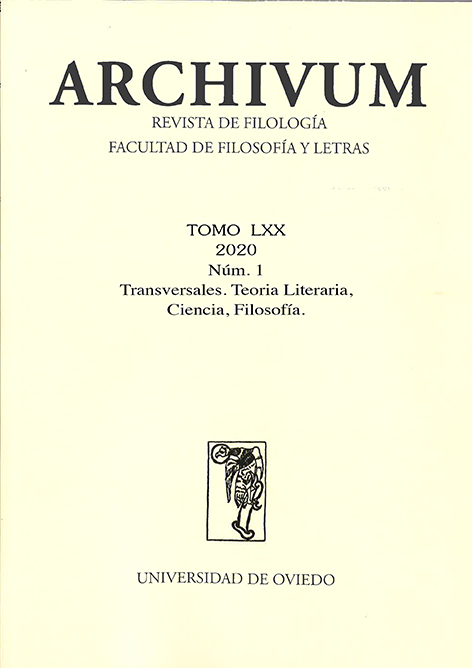Abstract
The present article proposes the reading of three science-fiction works: Stefano Benni’s Terra!, Douglas Adams’s The Hitchhiker’s Guide to the Galaxy and Philip K. Dick’s The Man in the High Castle. Drawing from the theoretical concept of ‘impossible worlds’ we aim to explain the deautomatizing effect of these fictions, which leads the reader to a psychological state akin to Fisher’s ‘weirdness‘. With this perspective, we will explore the way in which the authors introduce unusual elements in the structural and semantic levels of the text to provoke in the audience an external incomprehension of the fictional universe and, thus, the inner evaluation of their cognoscitive system. In order to gain a deeper comprehension of how the actual world is structured, it shall be required to approach how we understand scientific endeavour, drawing a distinction between expert and non-expert conceptions.
References
ADAMS, D. (1988) Hasta luego, y gracias por el pescado, Barcelona, Anagrama.
ADAMS, D. (1994) Informe sobre la Tierra: fundamentalmente inofensiva, Barcelona, Anagrama.
ADAMS, D. (2003) “Is There an Artificial God?”, The Salmon of Doubt, London, Macmillan, 126-150.
ALBALADEJO MAYORDOMO, T. (1998)Teoría de los mundos posibles y macroestructura narrativa, Alicante, Universidad de Alicante.
BENNI, S. (1986) ¡Tierra!, Barcelona, Anagrama.
BERGER, P. L. y T. LUCKMANN (1997) La construcción social de la realidad, Buenos Aires, Amorrortu.
ECO, U. (1979) “Lector in Fabula: Pragmatic Strategy in a Metanarrative Text”, The Role of the Reader, Bloomington, Indiana University Press, 200-260.
ECO, U. (1988) “Los mundos de la ciencia ficción”, De los espejos y otros ensayos, Barcelona: Lumen, 185-192.
FEYERABEND, P. (1984) Adiós a la razón, Madrid, Tecnos.
FISHER, M. (2016) Lo raro y lo espeluznante, Barcelona, Alpha Decay.
KRISTEVA, J. (2001) Semiótica I, Madrid, Fundamentos.
KUHN, T. S. (1988) La estructura de las revoluciones científicas, México / Madrid / Buenos Aires, Fondo de Cultura Económica.
LEM, S. (1978) Diarios de las estrellas. Viajes, Barcelona, Bruguera.
LEWIS, D. (1978) “The Truth in Fiction”, American Philosophical Quarterly, 15, 1, 37-46.
MARTÍN JIMÉNEZ, A. (2015a) “A Theory of Impossible Worlds”, Castilla, 6, 1-40.
MARTÍN JIMÉNEZ, A. (2015b) Literatura y ficción. La ruptura de la lógica ficcional, Bern, Peter Lang.
MCHALE, B. (2004) Postmodernist Fiction, London / New York, Routledge.
MONTFOURT, P. (2016) “The I Ching and Philip K. Dick’s The Man in the High Castle”, Science Fiction Studies, 43, 2, 287-309.
MUKAROVSKY, J. (1977) Escritos de Estética y Semiótica del Arte, Barcelona, Gustavo Gili.
PUTNAM, H. (1984) “El significado de “significado”, Teorema: Revista Internacional de Filosofía, vol. 14, n.º 3-4, págs. 345-406.
RODRÍGUEZ PEQUEÑO, J. (1997) “Mundos imposibles: ficciones posmodernas”, Castilla: Estudios de Literatura, 22, 179-188.
RODRÍGUEZ PEQUEÑO, J. (2008) Géneros literarios y mundos posibles, Madrid, Eneida.
RYAN, M.-L. (1991) Possible Worlds, Artificial Intelligence and Narrative Theory, Indiana, University of Bloomington & Indianapolis Press.
SÁNCHEZ ARTEAGA, J. (2007) La razón salvaje. La lógica del dominio: tecnociencia, racismo y racionalidad, Madrid, Lengua de Trapo.
SUVIN, D. (1984) Metamorfosis de la ciencia ficción, México D. F., Fondo de Cultura Económica.
TODOROV, T. (1981) Introducción a la literatura fantástica, México, Premia.
TODOROV, T. (2012) Los géneros del discurso, Buenos Aires, Waldhuter Editores.


